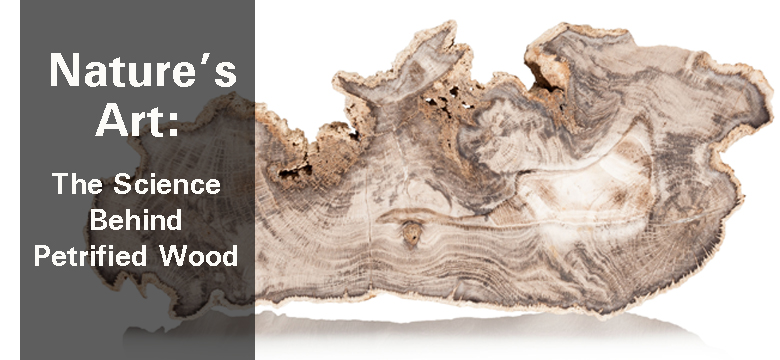
As a student of Environmental Studies, I cannot stress enough the importance and utility of understanding Earth’s natural processes. Whether noticing striated cirrus clouds (a tell-tale sign of impending rain) or feeling the shift in the wind from the south to the north as summer turns to fall, possessing and seeking out knowledge of how our planet works not only makes you sound “in the know”, but it is also exceptionally helpful and useful in daily life. However, some natural processes, like the shift from a southerly wind to a northerly one, are more easily explained and experienced than others.
Petrified Wood, one of nature’s oldest, most beautiful, and rarest creations, is one of those phenomena that takes a little more than a few hours spent outside to understand. 
The process, obviously, begins with trees. However, not just any trees; we’re talking ANCIENT TREES. These trees lived (and died) millions of years ago, sometimes a mere hundreds of thousands of years ago. Truthfully, it doesn’t take long for wood to petrify (labs in Japan have proved the process can be recreated successfully in a matter of months); the part that takes so long is waiting on the right natural conditions for petrification to take place.
So, what are the right conditions?
First, there must be a severe lack of oxygen. Normal processes of decay usually take place in oxygen-rich environments filled with microorganisms and other little critters eager to eat their way through any organic material, thus leaving behind unrecognizable masses of matter. Therefore, for petrification of wood to occur, ancient trees need to be buried under mud, sediments, and ideally, mineral-rich volcanic ash, so that no oxygen can get in. That being said, this suffocation needs to happen quickly, or normal decay will begin, resulting in a less perfect petrified specimen!
Once in a watery, muddy grave, the wood is exposed to a slew of minerals, predominately silica (especially if there is volcanic ash involved). Add some pressure (via more sediments/mud/what have you), and some heat, and now we’re really cookin’!
 Wood, because it is porous, slowly becomes infiltrated by silica and other surrounding minerals. These minerals penetrate into the wood cell by cell and begin to dissolve the cell walls, while retaining the stability and structure of the wood. The longer the wood remains under these conditions, the more time the minerals have to work their magic through the wood. Eventually, all of what was once organic material is then replaced by minerals, which literally turns the wood to stone.
Wood, because it is porous, slowly becomes infiltrated by silica and other surrounding minerals. These minerals penetrate into the wood cell by cell and begin to dissolve the cell walls, while retaining the stability and structure of the wood. The longer the wood remains under these conditions, the more time the minerals have to work their magic through the wood. Eventually, all of what was once organic material is then replaced by minerals, which literally turns the wood to stone.
If you find yourself yearning to learn more about petrified wood, there are many places all over the world you can visit, several of which are in the United States. Remember, it is a Federal Crime to take any petrified wood from these unique localities. So, if you’re eager to start a collection of fossilized wood specimens, be sure to check out Heritage’s Weekly Nature and Science Internet Auctions! We’ve got some truly “banger” pieces.
By Grace Evanko


I have about 15 tons of petrified wood from South Dakota that I would like to sell. Most pieces are chunks of 12″ to 24″ + inches. Color ranges from black to white. Do you have an interest in buying the lot, or perhaps a colleague that might?
Hi Wolf, thank you for contacting us. I am not sure if we would have the right market for petrified wood however we do offer FREE auction evaluations. Our experts would be able to give you more information about selling or consigning. Please visit : https://www.ha.com/c/acquisitions.zx?target=auctionevaluation&type=kk-fb-cs-freeeval-070714
Thank you!
Is petrified wood from most locations valuable? Or in other words, is it pretty when sliced and polished? I live in Kansas and discovered many years ago a rather large petrified log that is gradually being exposed due to erosion. I have several large pieces that I’ve brought home over a period of time. Some as big as 14″ x 10″ x 4″. They are beautiful as they are what with all the sparkling crystals. I would really hate to ruin one of these chunks by slicing and ending up with possibly a much less appealing specimen.